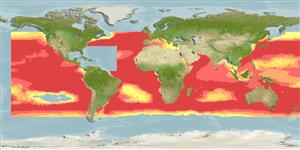Klassifizierung / Names
Namen | Synonyme | Catalog of Fishes (gen., sp.) | ITIS | CoL | WoRMS | Cloffa
Elasmobranchii (Haie und Rochen) (sharks and rays) >
Myliobatiformes (Stingrays) >
Dasyatidae (Stingrays)
Etymology: Pteroplatytrygon: Greek, pteron = wing, fin + Greek,platys = flat + Greek, trygon = a sting ray (Ref. 45335); violacea: From the Latin 'viola' meaning violet.
Lebensraum / Klimazone / Range
Ökologie
; seewasser; tiefenbereich 1 - 381 m (Ref. 58302), usually 1 - 100 m (Ref. 55209). Subtropical, preferred ?; 52°N - 50°S, 167°W - 180°E (Ref. 55209)
Probably cosmopolitan in tropical and subtropical seas. Eastern Atlantic: southeastern coasts of the Mediterranean and off Sicily. Reported from Cape Verde (Ref. 34514). Eastern Pacific: California (USA), Baja California (Mexico), and the Galapagos Islands Reported off Vancouver (Ref. 11980) and from Chile (Ref. 9068). Western Atlantic (Ref. 7251). There are 4 records from southern Africa (Ref. 11228).
Length at first maturity / Size / Gewicht / Alter
Maturity: Lm ?, range 40 - 50 cm
Max length : 96.0 cm WD Männchen/unbestimmt; (Ref. 48844); common length : 80.0 cm WD Männchen/unbestimmt; (Ref. 9254)
A thick, dark stingray with a broadly rounded snout and an angular pectoral disc; tail less than twice body length with a long lower caudal finfold ending far in front of tail tip, but with no upper finfold; disc without thorns; usually 1 extremely long sting on tail; eyes do not protrude (Ref. 5578). Uniformly violet, purple, or dark blue-green dorsally and ventrally (Ref. 3263). No prominent markings (Ref. 3263).
Found in open, tropical and warm temperate waters usually in the first 100 m. Possibly the only totally pelagic member of the family (Ref. 6871). Feeds on coelenterates (including medusae), squid, decapod crustaceans, and fish. Ovoviviparous (Ref. 50449). Venomous spine on tail. Common catch of the pelagic tuna (and shark) longline and gillnet fisheries (drift, Ref. 75025) operating throughout the region (Ref. 58048); also by purse-seine and bottom trawls (Ref. 75025). Utilized for its meat and sometimes cartilage (Ref.58048). Total length 110 TL (80 cm WD) (Ref. 9254).
Exhibit ovoviparity (aplacental viviparity), with embryos feeding initially on yolk, then receiving additional nourishment from the mother by indirect absorption of uterine fluid enriched with mucus, fat or protein through specialised structures (Ref. 50449). Distinct pairing with embrace (Ref. 205). With 2 (Ref.58048) to 9 young born at 15-25 cm WD (Ref. 26346); after a gestation period of 4 months (Ref.58048).
Compagno, L.J.V., 1999. Checklist of living elasmobranchs. p. 471-498. In W.C. Hamlett (ed.) Sharks, skates, and rays: the biology of elasmobranch fishes. Johns Hopkins University Press, Maryland. (Ref. 35766)
IUCN Rote Liste Status (Ref. 115185)
CITES (Ref. 94142)
Not Evaluated
Nutzung durch Menschen
Mehr Information
ReferenzenAquakulturAquakultur ProfilZuchtlinienGenetikAllel-HäufigkeitenVererbbarkeitKrankheitenVerarbeitungMass conversion
Tools
Zusatzinformationen
Download XML
Internet Quellen
Estimates of some properties based on models
Phylogenetic diversity index (Ref.
82805): PD
50 = 1.0000 [Uniqueness, from 0.5 = low to 2.0 = high].
Trophic Level (Ref.
69278): 4.4 ±0.54 se; Based on food items.
Widerstandsfähigkeit (Ref.
69278): sehr niedrig, Verdopplung der Population dauert mehr als 14 Jahre. (K=0.18 (captivity); Fec=1-9 (could probably have 2 litters per year)).
Verwundbarkeit (Ref.
59153): High to very high vulnerability (66 of 100) .
